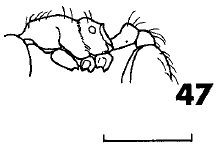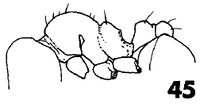Carebara hannya
| Carebara hannya | |
|---|---|

| |
| Scientific classification | |
| Kingdom: | Animalia |
| Phylum: | Arthropoda |
| Class: | Insecta |
| Order: | Hymenoptera |
| Family: | Formicidae |
| Subfamily: | Myrmicinae |
| Tribe: | Crematogastrini |
| Genus: | Carebara |
| Species: | C. hannya |
| Binomial name | |
| Carebara hannya (Terayama, 1996) | |
| Common Name | |
|---|---|
| Hime-kotsuno-ari | |
| Language: | Japanese |
This rare species is found in forests and at forest margins, and nests in soil and rotting wood (Japanese Ant Image Database).
Identification
Distribution
Distribution based on Regional Taxon Lists
Palaearctic Region: Japan (type locality).
Distribution based on AntMaps
Distribution based on AntWeb specimens
Check data from AntWeb
Countries Occupied
| Number of countries occupied by this species based on AntWiki Regional Taxon Lists. In general, fewer countries occupied indicates a narrower range, while more countries indicates a more widespread species. |

|
Estimated Abundance
| Relative abundance based on number of AntMaps records per species (this species within the purple bar). Fewer records (to the left) indicates a less abundant/encountered species while more records (to the right) indicates more abundant/encountered species. |

|
Biology
Castes
Worker
 
| |
| . | |
Nomenclature
The following information is derived from Barry Bolton's Online Catalogue of the Ants of the World.
- hannya. Oligomyrmex hannya Terayama, 1996: 21, figs. 44-47 (s.w.) JAPAN.
- Type-material: holotype major worker, 5 paratype major workers, 12 paratype minor workers.
- Type-locality: holotype Japan: Okinawa Pref., Okinawa-jima, Syuri, 6.x.1988 (M. Terayama); paratypes: 2 major workers, 5 minor workers with same data, 2 major workers, 5 minor workers Okinawa-jima, Chibana, 19.v.1983 (T. Mizukami), 1 major worker, 2 minor workers Okinawa-jima, Chinen, 26.viii.1975 (T. Abe).
- Type-depositories: MNHA (holotype); NIAS, NSMT (paratypes).
- Combination in Carebara: new combination (unpublished).
- Status as species: Imai, et al. 2003: 131.
- Distribution: Japan.
Unless otherwise noted the text for the remainder of this section is reported from the publication that includes the original description.
Description
Worker
Holotype. Major. HL 0.50 mm; HW 0.40 mm; SL 0.23 mm; CI 80; SI 58; WL 0.43 mm; PL 0.18 mm; PH 0.13 mm; DPW 0.08 mm; TL 1.3 mm.
Head 1.3 x as long as wide, with parallel sides and weakly convex posterior margin in frontal view; vertex with a pair of small tubercles. Mandibles with 5 teeth. Antennae with 9 segments; scape short, 0.5 x head length; 2nd segment longer than wide; 3rd to 7th segments each wider than long; 8th segment slightly longer than wide; 9th segment 2.8 x as long as wide. Eyes small, each consisting of 2 facets only. Ocelli absent.
Alitrunk as in Fig.; dorsum of promesonotum broadly convex in lateral view; metanotal groove deeply incised dorsally; mesopleura without transverse groove; anterior half of propodeal dorsum strongly convex and posterior half almost straight. Posterior margins of propodeum with a thin lamella; posterodorsal comers of propodeum angulated, not forming a spine.
Petiole longer than high, with convex dorsal margin; subpetiolar process forming an acute anteroventral tooth. Postpetiole slightly higher than long, with convex dorsal margin in lateral view.
Head very weakly microreticulate; genae with many longitudinal striae; promesonotum smooth and shining; mesopleura and propodeum microreticulate; waist weakly microreticulate; gaster smooth.
Body yellowish brown.
Paratype minors. HL 0.31-0.33 mm; HW 0.28-0.29 mm; SL 0.23 mm; CI 88-90; SI 78-82; WL 0.42-0.43 mm; PL 0.11 mm; PH 0.09 mm; DPW 0.06 mm; TL 0.9-1.0 mm (n = 5).
Head square, with subparallel sides and weakly concave posterior margin in frontal view. Mandibles with 5 teeth. Eyes small, consisting of a single facet only. Antennae with 9 segments; 3rd to 7th segments each wider than long; 8th segment as long as wide; apical segment 2.4x as long as wide.
Promesonotal dorsum broadly convex in lateral view; metanotal groove strongly incised dorsally; propodeal dorsum weakly convex; posterior margins of propodeum with a thin lamella; its dorsalmost part obscurely angulated. Petiole longer than high, with convex dorsal margin in lateral view; subpetiolar process fornting an acute anteroventral tooth. Postpetiole longer than high, with broadly convex dorsal margin in lateral view.
Head smooth with shallow punctures sparsely; pronotum smooth and shining; mesopleura and propodeum microreticulate; waist microreticulate excepting disc of postpetiole smooth; gaster smooth and subopaque.
Body yellowish brown.
Type Material
Holotype. Major worker, Syuri, Okinawa-jima, Okinawa Pref., 6.X.1988, M. Terayama leg. Paratypes. 2 major workers, 5 minor workers, same data as holotype; 2 major workers, 5 minor workers, Chibana, Okinawa-jima, Okinawa Pref., 19.V.1983, T. Mizukami leg.; major worker, 2 minor workers, Chinen, Okinawa-jima, Okinawa Pref., 26.VIII.1975, T. Abe leg.
Etymology
The specific name is the Japanese noun hannya, which is the name of a Japanese deity who has a pair of horns on head.
References
- Terayama, M. 1996b. Taxonomic studies on the Japanese Formicidae, part 2. Seven genera of Ponerinae, Cerapachyinae and Myrmicinae. Nature and Human Activities. 1:9-32. (page 21, figs. 44-47 soldier, worker described)
References based on Global Ant Biodiversity Informatics
- Terayama M. 1996. Taxonomic studies on the Japanese Formicidae, part 2. Seven genera of Ponerinae, Cerapachyinae and Myrmicinae. Nature & Human Activities 1: 9-32.
- Terayama M., S. Kubota, and K. Eguchi. 2014. Encyclopedia of Japanese ants. Asakura Shoten: Tokyo, 278 pp.
- Yamane S., S. Ikudome, and M. Terayama. 1999. Identification guide to the Aculeata of the Nansei Islands, Japan. Sapporo: Hokkaido University Press, xii + 831 pp. pp, 138-317.
- Yamane S.; Ikudome, S.; Terayama, M. 1999. Identification guide to the Aculeata of the Nansei Islands, Japan. Sapporo: Hokkaido University Press, xii + 831 pp. pp138-317.
